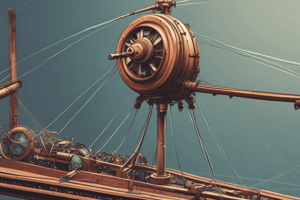Podcast
Questions and Answers
What is a lever?
What is a lever?
A lever is a rigid structure that moves around a fixed point, the fulcrum.
What role does the resistance (load) (L) play in a lever system?
What role does the resistance (load) (L) play in a lever system?
The resistance (load) opposes movement.
What role does the effort (E) play in a lever system?
What role does the effort (E) play in a lever system?
The effort causes movement.
In the human body, what serves as levers?
In the human body, what serves as levers?
In the human body, what serves as fulcrums?
In the human body, what serves as fulcrums?
What is the resistance in a lever system involving the human body?
What is the resistance in a lever system involving the human body?
What role does muscle contraction play in a lever system?
What role does muscle contraction play in a lever system?
How does the distance of muscle attachment from the joint affect the force produced?
How does the distance of muscle attachment from the joint affect the force produced?
What advantage does a muscle have if it attaches closer to the joint?
What advantage does a muscle have if it attaches closer to the joint?
What is mechanical advantage in the context of lever systems?
What is mechanical advantage in the context of lever systems?
What is necessary for the production of movement around a joint?
What is necessary for the production of movement around a joint?
Where is the origin of a muscle's tendon usually located?
Where is the origin of a muscle's tendon usually located?
What is the term for the attachment of a muscle's tendon to the stationary bone?
What is the term for the attachment of a muscle's tendon to the stationary bone?
How must one bone behave to enable joint movement?
How must one bone behave to enable joint movement?
What describes the bone that does not move during muscle contraction?
What describes the bone that does not move during muscle contraction?
Flashcards are hidden until you start studying
Study Notes
Lever Systems and Leverage
- A lever is a rigid structure that moves around a fixed point called the fulcrum (F)
- Two forces act on a lever: resistance (load) (L) opposing movement and effort (E) causing movement
Bones as Levers and Joints as Fulcrums
- Bones serve as levers and joints serve as fulcrums
- In joints, one bone must be stationary while another bone moves
Origins and Insertions
- The attachment of a muscle's tendon to the stationary (usually proximal) bone is called the origin
- The attachment of a muscle's tendon to the moving bone is called the insertion
Mechanical Advantage
- The muscle attached farther from the joint produces the most force
- The muscle attached closer to the joint has a greater range of motion and faster speed
Studying That Suits You
Use AI to generate personalized quizzes and flashcards to suit your learning preferences.




